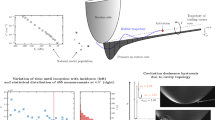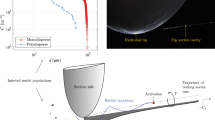Abstract
Inception and desinence thresholds of tip vortex cavitation (TVC), generated by an elliptical NACA 16-020 hydrofoil, are measured at different flow conditions for various gas contents. It is observed that TVC often disappears at cavitation indices significantly higher than the inception thresholds introducing large hystereses. Our measurements reveal that TVC desinence pressure increases with gas content and, under specific flow conditions, may reach to atmospheric pressure. When the pressure of the cavitating core is below the initial saturation pressure of the dissolved gases, water flowing adjacent to the interface becomes supersaturated, which leads to the diffusion of air molecules into TVC. To estimate the outgassing rate, a simple diffusion model is proposed and analytically solved. In addition, we demonstrate that the extent of the delay in desinence due to outgassing is also dictated by the bulk flow parameters, i.e., the incidence angle and freestream velocity. Owing to flow visualizations, we assert that formation of a laminar separation bubble of appropriate size and shape at the hydrofoil tip is a necessary condition for a delayed desinence. The separation bubble acts like a shelter and creates a relatively calm area at the vortex core by forcing the incoming flow to wrap around the axis. By roughening the hydrofoil tip, we demonstrate that the hysteresis is completely suppressed once the laminar separation bubble is destroyed. Moreover, our velocity measurements show that at near-wake, the incidence angle associated with delayed desinence is accompanied by a jet-like axial velocity profile while a wake-like profile is observed for the low-hysteresis case.
Graphic abstract















Similar content being viewed by others
References
Arndt REA (2002) Cavitation in vortical flows. Annu Rev Fluid Mech 34:143–175. https://doi.org/10.1146/annurev.fluid.34.082301.114957
Arndt R, Keller A (1992) Water-quality effects on cavitation inception in a trailing vortex. J Fluids Eng Trans ASME 114:430–438. https://doi.org/10.1115/1.2910049
Arndt REA, Maines BH (2000) Nucleation and bubble dynamics in vortical flows. J Fluids Eng Trans ASME 122:488–493. https://doi.org/10.1115/1.1286994
Arndt R, Arakeri V, Higuchi H (1991) Some observations of tip-vortex cavitation. J Fluid Mech 229:269–289. https://doi.org/10.1017/S0022112091003026
Arndt R, Pennings P, Bosschers J, van Terwisga T (2015) The singing vortex. Interf Focus 5:20150025. https://doi.org/10.1098/rsfs.2015.0025
Bastos F, de Rachid F (2014) Modeling gaseous and vaporous cavitation in liquid flows within the context of the thermodynamics of irreversible processes. Int J Non-linear Mech 65:245–252. https://doi.org/10.1016/j.ijnonlinmec.2014.06.006
Billet ML, Weir DS (1975) The effect of gas diffusion on the flow coefficient for a ventilated cavity. J Fluids Eng 97:501–505
Birch D, Lee T, Mokhtarian F, Kafyeke F (2004) Structure and induced drag of a tip vortex. J Aircr 41:1138–1145. https://doi.org/10.2514/1.2707
Boulon O, Callenaere M, Franc JP, Michel JM (1999) An experimental insight into the effect of confinement on tip vortex cavitation of an elliptical hydrofoil. J Fluid Mech 390:1–23. https://doi.org/10.1017/S002211209900525X
Brennen CE (2014) Cavitation and bubble dynamics. Cambridge University Press, Cambridge
Chang N, Ganesh H, Yakushiji R, Ceccio SL (2011) Tip vortex cavitation suppression by active mass injection. J Fluids Eng Trans ASME 133:111301. https://doi.org/10.1115/1.4005138
Decaix J, Balarac G, Dreyer M et al (2015) RANS and LES computations of the tip-leakage vortex for different gap widths. J Turbul 16:309–341
Dreyer M (2015) Mind the gap: tip leakage vortex dynamics and cavitation in axial turbines. PhD Thesis, PhD thesis, EPFL, Lausanne, Switzerland
Dreyer M, Decaix J, Muench-Alligne C, Farhat M (2014) Mind the gap: a new insight into the tip leakage vortex using stereo-PIV. Exp Fluids 55:1849. https://doi.org/10.1007/s00348-014-1849-7
Escaler X, Egusquiza E, Farhat M et al (2006) Detection of cavitation in hydraulic turbines. Mech Syst Signal Process 20:983–1007. https://doi.org/10.1016/j.ymssp.2004.08.006
Franc J, Michel J (1985) Attached cavitation and the boundary-layer—experimental investigation and numerical treatment. J Fluid Mech 154:63. https://doi.org/10.1017/s0022112085001422
Fruman D, Cerrutti P, Pichon T, Dupont P (1995) Effect of hydrofoil planform on tip vortex roll-up and cavitation. J Fluids Eng Trans ASME 117:162–169. https://doi.org/10.1115/1.2816806
Gaster M (1969) The structure and behaviour of laminar separation bubbles. HM Stationery Office, Richmond
Gopalan S, Katz J (2000) Flow structure and modeling issues in the closure region of attached cavitation. Phys Fluids 12:895–911. https://doi.org/10.1063/1.870344
Green S (1991) Correlating single-phase flow measurements with observations of trailing vortex cavitation. J Fluids Eng Trans ASME 113:125–129. https://doi.org/10.1115/1.2926484
Green S, Acosta A (1991) Unsteady-flow in trailing vortices. J Fluid Mech 227:107–134. https://doi.org/10.1017/S0022112091000058
Gross TF, Pelz PF (2017) Diffusion-driven nucleation from surface nuclei in hydrodynamic cavitation. J Fluid Mech 830:138–164. https://doi.org/10.1017/jfm.2017.587
Gross TF, Bauer J, Ludwig G et al (2018) Bubble nucleation from micro-crevices in a shear flow. Exp Fluids 59:12. https://doi.org/10.1007/s00348-017-2459-y
Holl JW, Arndt REA, Billet ML (1972) Limited cavitation and the related scale effects problem. In: Proceedings of 2nd international symposium on fluid mechanics and fluidics, JSME, Tokyo, pp 303–314
Horton HP (1968) Laminar separation bubbles in two and three dimensional incompressible flow (Doctoral dissertation). Queen Mary College, University of London, UK
Ito Y, Oba R (1985) A limited role of separation bubble in desinent cavitation. J Fluids Eng Trans ASME 107:121–126. https://doi.org/10.1115/1.3242427
Keller AP (2001) Cavitation Scale Effects-empirically found relations and the correlation of cavitation number and hydrodynamic coefficients. Httpresolver Caltech Educ Lect 001
Lee T, Pereira J (2010) Nature of wakelike and jetlike axial tip vortex flows. J Aircr 47:1946–1954. https://doi.org/10.2514/1.C000225
Lee I, Maekiharju SA, Ganesh H, Ceccio SL (2016) Scaling of gas diffusion into limited partial cavities. J Fluids Eng Trans ASME 138:051301. https://doi.org/10.1115/1.4031850
Lee C-S, Ahn B-K, Han J-M, Kim J-H (2018) Propeller tip vortex cavitation control and induced noise suppression by water injection. J Mar Sci Technol 23:453–463. https://doi.org/10.1007/s00773-017-0484-4
Leroux JB, Astolfi JA, Billard JY (2001) An experimental investigation of partial cavitation on a two dimensional hydrofoil. In: CAV2001 fourth international symposium on Cavitation, pp 20–23
Li X, Song Y, Hao Z, Gu C (2012) Cavitation mechanism of oil-film bearing and development of a new gaseous cavitation model based on air solubility. J Tribol 134:031701
Ling-xin Z, Na Z, Xiao-xing P et al (2015) A review of studies of mechanism and prediction of tip vortex cavitation inception. J Hydrodyn 27:488–495. https://doi.org/10.1016/S1001-6058(15)60508-X
Luo X, Ji B, Tsujimoto Y (2016) A review of cavitation in hydraulic machinery. J Hydrodyn 28:335–358. https://doi.org/10.1016/S1001-6058(16)60638-8
Maines BH, Arndt REA (1993) Viscous effects on tip vortex cavitation. ASME Publ FED 177:125
Maines BH, Arndt REA (1997) Tip vortex formation and cavitation. J Fluids Eng Trans ASME 119:413–419. https://doi.org/10.1115/1.2819149
Makiharju SA, Ganesh H, Ceccio SL (2017) The dynamics of partial cavity formation, shedding and the influence of dissolved and injected non-condensable gas. J Fluid Mech 829:420–458. https://doi.org/10.1017/jfm.2017.569
McCormick BW (1962) On cavitation produced by a vortex trailing from a lifting surface. J Basic Eng 84:369–378
Parkin B, Ravindra K (1991) Convective gaseous diffusion in steady axisymetric cavity flows. J Fluids Eng 113:285–289
Pauchet A, Briangon-Marjollet L (1970) Recent results on tip vortex cavitation scale effects at high reynolds numbers. In: WIT transactions on the built environment, vol 1. WIT Press. https://doi.org/10.2495/NEVA930131
Pennings PC, Westerweel J, van Terwisga TJC (2015) Flow field measurement around vortex cavitation. Exp Fluids 56:206. https://doi.org/10.1007/s00348-015-2073-9
Roussopoulos K, Monkewitz PA (2000) Measurements of tip vortex characteristics and the effect of an anti-cavitation lip on a model Kaplan turbine blade. Flow Turbul Combust 64:119–144. https://doi.org/10.1023/A:1009976411156
Shen YT, Gowing S, Jessup S (2009) Tip vortex cavitation inception scaling for high Reynolds number applications. J Fluids Eng-Trans ASME 131:071301. https://doi.org/10.1115/1.3130245
Song M, Xu L, Peng X, Tang D (2017) An acoustic approach to determine tip vortex cavitation inception for an elliptical hydrofoil considering nuclei-seeding. Int J Multiph Flow 90:79–87. https://doi.org/10.1016/j.ijmultiphaseflow.2016.12.008
Souders WG, Platzer GP (1981) Tip vortex cavitation characteristics and delay of inception on a three-dimensional hydrofoil. Research and development rept. (No. DTNSRDC-81/007). David W. Taylor Naval Ship Research and Development Center, Bethesda, Maryland, US
Acknowledgements
The present research received funding from the MSCA-ITN-ETN of the European Union’s H2020 program under REA Grant agreement No. 642536, and Mitsubishi Heavy Industries, Ltd. (Japan).
Author information
Authors and Affiliations
Corresponding author
Additional information
Publisher’s Note
Springer Nature remains neutral with regard to jurisdictional claims in published maps and institutional affiliations.
Electronic supplementary material
Below is the link to the electronic supplementary material.
Rights and permissions
About this article
Cite this article
Amini, A., Reclari, M., Sano, T. et al. On the physical mechanism of tip vortex cavitation hysteresis. Exp Fluids 60, 118 (2019). https://doi.org/10.1007/s00348-019-2762-x
Received:
Revised:
Accepted:
Published:
DOI: https://doi.org/10.1007/s00348-019-2762-x




